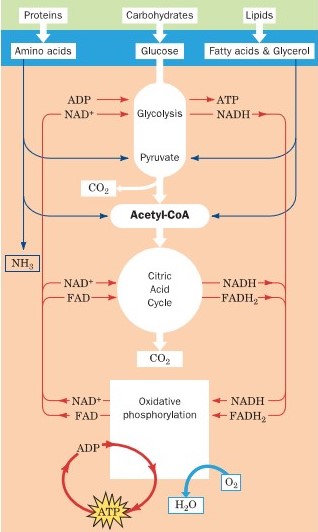METABOLISM
Thousands of reactions simultaneously take place in a living cell, in a well-organized and integrated manner. The entire spectrum of chemical reactions, occurring in the living system, are collectively referred to as the metabolism. In simple terms, metabolism refers to all the enzymatic reactions occurring in the cell.
Types of metabolism
Two types namely 1)intermediary metabolism and 2)energy metabolism
Intermediary metabolism
this deals with the chemical reactions within cells and tissue. the term intermediary metabolism is used and the intermediates are called the metabolites. In general, the term metabolism refers to intermediary metabolism and it includes all the biochemical processes within the cells and tissues which are concerned with their building up, breaking down, and functioning.
Energy metabolism
This deals with the overall energy production in an organism.it is simply the energy component of intermediary metabolism, Where the chemical energy derived from the degradative reactions is conserved to be utilized for synthetic processes-hence also known as Bioenergetics
A metabolic pathway (or metabolic map) constitutes a series of enzymatic reactions to produce specific products. The term metabolite is applied to a substrate or an intermediate or a product in the metabolic reactions. Metabolism is broadly divided into two categories
1. Catabolism: The degradative processes concerned with the breakdown of complex molecules to simpler ones, with a concomitant release of energy.
 |
| ANABOLISM AND CATABOLISM |
A clear demarcation between catabolism and anabolism is rather difficult since there are several intermediates common to both processes. The term amphibolic is also in use for reactions that are both catabolic and anabolic in nature.
Catabolism
The very purpose of catabolism is to trap the energy of the biomolecules in the form of ATP and to generate the substances (precursors) required for the synthesis of complex molecules. Catabolism occurs in three stages.
1. Conversion of complex molecules into their building blocks: Polysaccharides are broken down to monosaccharides, lipids to free fatty acids and glycerol, proteins to amino acids.
2. Formation of simple intermediates: The building blocks produced in stage (1) are degraded to simple intermediates such as pyruvate and acetyl CoA. These intermediates are not readily identifiable as carbohydrates, lipids, or proteins. A small quantity of energy (as ATP) is captured in stage 2.
 |
| OVERVIEW OF CATABOLISM |
Overview of catabolism. Complex metabolites such as carbohydrates, proteins, and lipids are degraded first to their monomeric units, chiefly glucose, amino acids, fatty acids, and glycerol, and then to the common intermediate, acetyl-coenzyme A (acetyl-CoA). The acetyl group is then oxidized to CO2 via the citric acid cycle with the concomitant reduction of NAD and FAD. Reoxidation of these latter coenzymes by O2 via the electron-transport chain and oxidative phosphorylation yields H2O and ATP
Anabolism
For the synthesis of a large variety of complex molecules, the starting materials are relatively few. These include pyruvate, acetyl CoA, and the intermediates of the citric acid cycle. Besides the availability of precursors, the anabolic reactions are dependent on the supply of energy (as ATP or GTP) and reducing equivalents (as NADPH + H+). The anabolic and catabolic pathways are not reversible and operate independently. As such, the metabolic pathways occur in specific cellular locations (mitochondria, microsomes, etc.) and are controlled by different regulatory signals. The terms—intermediary metabolism and energy metabolism—are also in use. Intermediary metabolism refers to the entire range of catabolic and anabolic reactions, not involving nucleic acids. Energy metabolism deals with the metabolic pathways concerned with the storage and liberation of energy.
Types of metabolic reactions
The biochemical reactions are mainly of four types
1. Oxidation-reduction.
2. Group transfer.
3. Rearrangement and isomerization.
4. Make and break carbon-carbon bonds.
These reactions are catalyzed by specific enzymes—more than 2,000 known so far.
Methods employed to study metabolism
The metabolic reactions do not occur in isolation. They are interdependent and integrated into specific series that constitute metabolic pathways. It is, therefore, not an easy task to study metabolisms. Fortunately, the basic metabolic pathways in most organisms are essentially identical. For this reason, many organisms can be used to understand metabolisms. Several methods are employed to elucidate biochemical reactions and metabolic pathways. These experimental approaches may be broadly divided into 3 categories
1. Use of whole organisms or their components.
2. Utility of metabolic probes.
3. Application of isotopes. The actual methods employed may be either in vivo (in the living system) or in vitro (in the test tube) or, more frequently, both.
1. Use of whole organism or its components :
(a) Whole organisms: The ultimate aim of a biochemist is to know the metabolism in the organism as a whole. Glucose tolerance test (GTT), employed to measure the response of man (or other animals) towards carbohydrate metabolism is a good example of the use of the whole organism.
(b) Isolated organs, tissue slices, whole cells, subcellular organelles, cell-free systems, and recently purified components are frequently used to elucidate biochemical reactions and metabolic pathways.
2. Utility of metabolic probes: Two types of metabolic probes are commonly used to trace out biochemical pathways. These are metabolic inhibitors and mutations. In both cases, there is a specific blockade in a metabolic reaction which helps to understand the pathway. Inhibitors of the electron transport chain have been largely responsible to elucidate the sequence of electron carriers. The inborn errors of metabolism in higher organisms and the genetic manipulations in the microorganisms have also contributed a lot to the understanding of metabolisms.
3. Application of isotopes: Isotopes are atoms with the same number of protons but different neutrons. By the use of isotopes, the molecules of the living system can be labeled without altering their chemical properties. The application of isotopes in biochemistry has revolutionized the study of metabolisms. More details on the utility of isotopes in biochemistry are given elsewhere.

Comments
Post a Comment